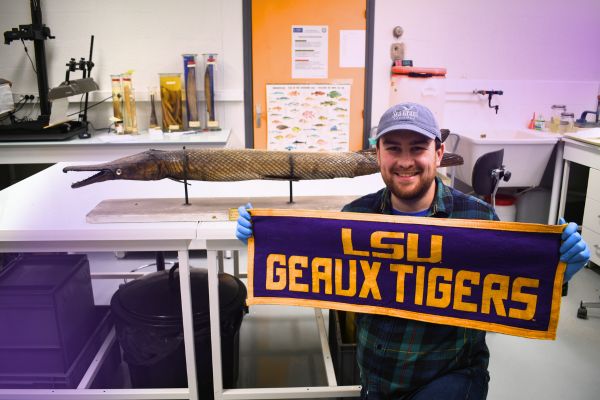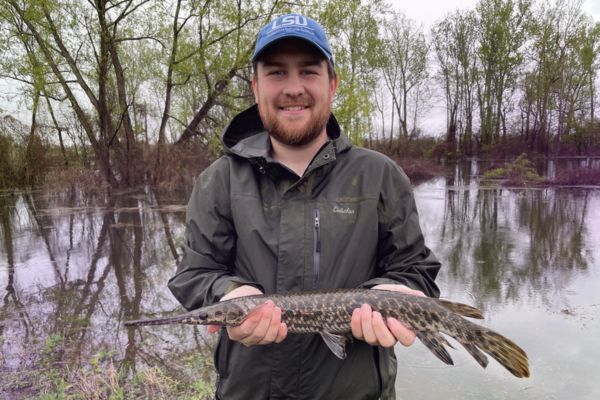Celebrating National Wildlife Week with Daniel Sinopoli: Rediscovering the Legacy of North America’s Ancient Fishes
April 09, 2025
Each spring, National Wildlife Week reminds us to reconnect with nature, celebrate its resilience, and honor those working to protect it. This year, we shine a spotlight on Daniel Sinopoli, a Ph.D. candidate of the Department of Biological Sciences, working in the Chakrabarty Lab at the LSU Museum of Natural Science, whose passion for fish and commitment to biodiversity are helping redefine our understanding of North America’s freshwater wildlife.

Dan Sinopoli with the original type specimen from 1803 used to describe Alligator Gar (Atractosteus spatula) at the Paris Museum of Natural History.
Daniel’s Journey From Fishing Poles to Field Notes
Daniel’s journey into the world of science began on the banks of upstate New York streams, fishing with his dad and observing nature firsthand. In the summer of 2012, Tropical Storm Irene swept through the Adirondacks, leaving behind a transformed landscape. Amid the destruction, Daniel noticed something miraculous: trout still schooling in a battered pond. That moment planted the seed of curiosity that would grow into a career in fisheries science.
Through high school research programs and hands-on fieldwork, Daniel developed a deep respect for the resilience of aquatic life. But it wasn’t until he encountered natural history collections during his undergraduate and master’s studies that he truly found his niche—museums, taxonomy, and evolutionary biology.
Daniel’s current research focuses on the taxonomy and life history of gars and bowfins—two groups of ancient fishes native to North America. Historically dismissed as “trash fish,” these species have been largely overlooked in conservation and scientific studies. Daniel’s mission is to change that.
“Due to decades of neglect, there may be more species of gar and bowfin than we currently recognize. We need to document this diversity before it disappears.”
By studying preserved specimens from centuries past, Daniel hopes to uncover new insights into their evolutionary relationships. In fact, a recent research trip took him all the way to the Muséum Nationale d'Histoire Naturelle in Paris, where he examined gar and bowfin specimens collected in the 1800s. It was a surprising yet deeply rewarding experience that underscores how global collaboration supports local conservation.

Dan holding a Spotted Gar (Lepisosteus oculatus) collected during field sampling in Louisiana.
For Daniel, science isn’t just about the lab—it’s about versatility. His work draws on everything from bioinformatics and statistics to chemistry and ecology. He encourages students pursuing STEM careers to start early and dive into research that feels personal. “Ask your professors what their labs are working on,” he advises. “You never know where it might lead. I started by helping a grad student and ended up inheriting their project!”
When he’s not immersed in his research, Daniel enjoys hiking and birdwatching, especially now that he’s experiencing Louisiana’s ecosystems for the first time. “Everything down here is new,” he says. “I’ve gained a much greater appreciation for every little thing out in nature.”
“I’ve gained a much greater appreciation for every little thing out in nature.”
As we celebrate National Wildlife Week 2025, Daniel Sinopoli reminds us that protecting wildlife begins with curiosity, compassion, and a willingness to look closer—especially at the creatures history has too often ignored. Through his work, forgotten fish are getting a second chance to be seen, studied, and saved.